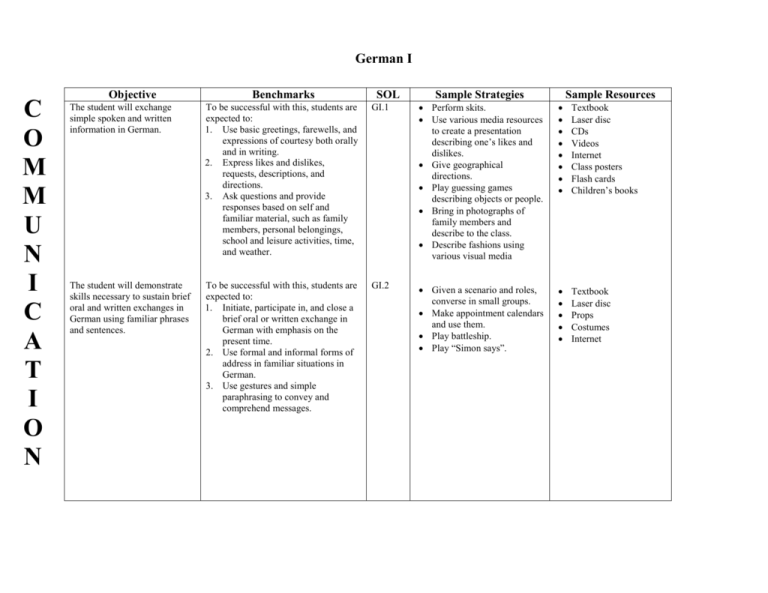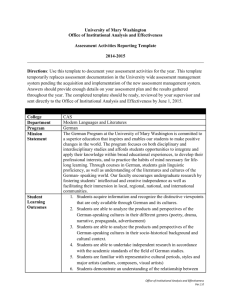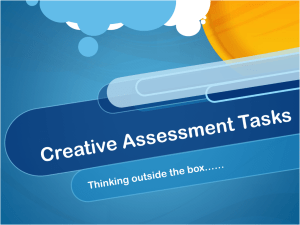Objective
advertisement

German I C O M M U N I C A T I O N Objective Benchmarks SOL Sample Strategies Sample Resources The student will exchange simple spoken and written information in German. To be successful with this, students are expected to: 1. Use basic greetings, farewells, and expressions of courtesy both orally and in writing. 2. Express likes and dislikes, requests, descriptions, and directions. 3. Ask questions and provide responses based on self and familiar material, such as family members, personal belongings, school and leisure activities, time, and weather. GI.1 Perform skits. Use various media resources to create a presentation describing one’s likes and dislikes. Give geographical directions. Play guessing games describing objects or people. Bring in photographs of family members and describe to the class. Describe fashions using various visual media Textbook Laser disc CDs Videos Internet Class posters Flash cards Children’s books The student will demonstrate skills necessary to sustain brief oral and written exchanges in German using familiar phrases and sentences. To be successful with this, students are expected to: 1. Initiate, participate in, and close a brief oral or written exchange in German with emphasis on the present time. 2. Use formal and informal forms of address in familiar situations in German. 3. Use gestures and simple paraphrasing to convey and comprehend messages. GI.2 Given a scenario and roles, converse in small groups. Make appointment calendars and use them. Play battleship. Play “Simon says”. Textbook Laser disc Props Costumes Internet German I C O M M U N I C A T I O N Objective Benchmarks SOL Sample Strategies The student will understand simple spoken and written German based on familiar topics that are presented through a variety of media. To be successful with this, students are expected to: 1. Identify the main ideas and some details when reading and listening in German. 2. Comprehend simple, culturally authentic announcements, messages, and advertisements that use familiar vocabulary and grammatical structures in German. 3. Understand simple instructions in German, such as classroom procedures or basic computer terminology. GI.3 Navigate German web sites and report to class on findings. Listen to German story and answer main idea questions. Read realia. The student will use verbal and non-verbal cues to understand simple spoken and written messages in German. To be successful with this, students are expected to: 1. Differentiate among statements, questions, and exclamations. 2. Use basic gestures, body language, and intonation to clarify the message. GI.4 Frame questions and respond accordingly. Express emotions prompted by stories or games. Sample Resources Textbook Videos Internet Poems Virtual maps Menus Catalogues Want ads Children’s books Textbook Videos Internet Stories Games German I C O M M U N I C A T I O N Objective Benchmarks The student will present orally and in writing information in German that contains a variety of familiar vocabulary, phrases, and structural patterns. To be successful with this, students are expected to: 1. Present in German information gathered from informal conversations, class presentations, interviews, readings, and/or a variety of media sources. 2. Describe in German basic familiar information, such as self, family members and others, events, interests, school, recreational activities, and personal belongings with emphasis on control of the present tense. 3. Demonstrate increasing attention to accuracy in intonation and pronunciation in German especially when presenting prepared material orally. 4. Demonstrate increasing attention to accuracy in word order, punctuation, accents and other diacritical marks, and spelling when writing in German. GI.5 SOL Give short oral presentations to the class in German. Learn and sing German songs. Use templates for German word order. Show movies in German. Listen to German music and stories. Sample Strategies Sample Resources Textbook Videos Dictionary Audio tapes German movies The student will present rehearsed material in German, including brief narratives, monologues, dialogues, poetry, and/or songs. To be successful with this, students are expected to: 1. Use appropriate verbal and nonverbal techniques, such as voice inflection, gestures, and facial expression. 2. Communicate ideas in an organized manner using appropriate visual and/or technological support. GI.6 Act out or recite poems, narratives, etc. Play charades. Play password. Write and present outlines about information learned. Textbook Videos Dictionary Audio tapes Internet German I C U L T U R E S Objective Benchmarks SOL Sample Strategies Sample Resources The student will develop an awareness of perspectives, practices and products of German-speaking cultures. To be successful with this, students are expected to: 1. Identify some viewpoints of German-speaking cultures, such as those relating to time, education, transportation, and the role of family members. 2. Identify some customs and traditions of German-speaking cultures, such as greetings, celebrations, holiday practices, and forms of address that demonstrate politeness. 3. Identify some historical and contemporary individuals associated with important events from German-speaking cultures. 4. Identify some products of Germanspeaking cultures, such as natural and manufactured items, creative and fine arts, recreation and pastimes, dwellings, language, and symbols. GI.7 Read about or watch videos about holidays in Germanspeaking countries. Carry on simulated telephone conversations. Research a famous Germanspeaking person, then report to class. Play Jeopardy or charades to demonstrate mastery of subject matter. Textbook Reference books Props Internet Dictionary The student will recognize that perspectives, practices, and products of German-speaking cultures are interrelated. To be successful with this, students are expected to: 1. Recognize that German-speaking cultures are shaped by viewpoints, customs/traditions, and products of speakers of German, such as the concept of Schultuete, Stammtisch, family celebrations, and foods. 2. Identify major cities and geographical features and why they are significant in German-speaking cultures. GI.8 Prepare a recipe from a German-speaking country. Contrast the geography of different countries. Locate a destination on a German map. Recipe book Maps Travel books Travel brochures German I C O N N E C T I O N S Objective Benchmarks The student will recognize how information acquired in the study of German and information acquired in other subjects reinforce one another. To be successful with this, students are expected to: 1. Identify examples of vocabulary, phrases, proverbs, and symbols from the German language that are used in other subjects. 2. Relate content from other subject areas to topics discussed in the German class, such as current events from German-speaking countries of the influence of German-speaking explorers on various regions of the United States. SOL GI.9 Sample Strategies Research current events in a German-speaking country. Compare and contrast the political systems of the US and of German-speaking countries. Write to pen pals. Interview a native speaker. Sample Resources Internet Native speakers Newspapers Magazines Textbook CD-ROMs German I C O M P A R I S O N S Objective Benchmarks The student will demonstrate an understanding of the significance of culture through comparisons between Germanspeaking cultures and the cultures of the United States. To be successful with this, students are expected to: 1. Compare patterns of behavior and interaction in the United States with those of German-speaking societies. 2. Demonstrate an awareness that social practices and personal interactions differ among cultures. 3. Demonstrate an awareness of unique elements of the student’s own culture. GI.10 SOL Use visual presentations to discuss German customs. Identify contributions of German-speaking countries to American culture. Sample Strategies Sample Resources Videos Textbook CD-ROMs Internet The student will compare basic elements of the German language to the English language. To be successful with this, students are expected to: 1. Recognize differences in sound systems, writing systems, cognates, gender, and level-appropriate idioms. 2. Recognize basic sound distinctions and intonation patterns and their effect on communicating meaning. GI.11 Identify correct cognates. Write and perform simple skits that include questions, idioms, and various intonations. Read aloud. Listen to simple descriptions, then draw a picture to correspond with the description. Props Costumes Textbook Poems Dictionary Audio tapes German I C O M M U N I T I E S Objective The student will identify situations in which German language skills and cultural knowledge may be applied beyond the classroom setting for recreational, educational, and occupational purposes. Benchmarks To be successful with this, students are expected to: 1. Identify examples of the German language and the cultures of German-speaking countries that are evident in and through media, entertainment, and technology. 2. Identify resources, such as individuals and organizations accessible through the community or Internet, that provide basic cultural information about the German-speaking world. SOL GI.12 Sample Strategies Prepare a report on a German-speaking country. Watch a German play of attend a cultural event. Research and prepare authentic German food. Research German leisure activities. Sample Resources Textbook Videos Internet Cook books Songs Plays




